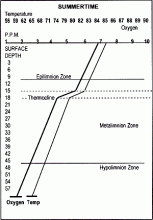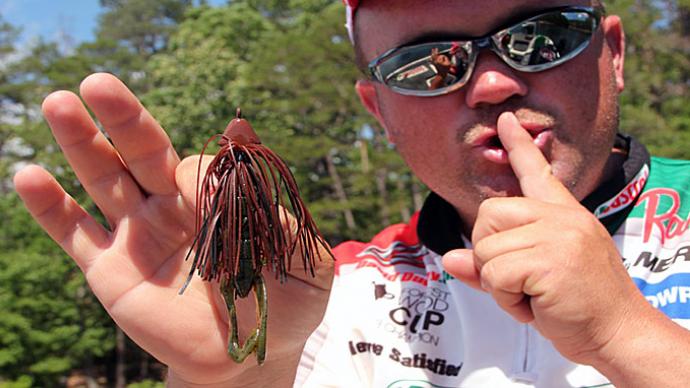You know, it seems like I've had a lot of people ask me about thermocline lately. Most of the time I haven't had enough time to explain what takes place in fresh water ecosystems, but you need to know about thermocline. It's very important to your fishing. I hope I can help you to understand it.
Lakes go through seasonal water temperature changes. There are times when the layers mix and then separate. Most lakes have three layers. The epilimnion, is the top layer.
When water temperatures rise in early summer, so does the density between the surface layer and the deeper layers. The hot surface water forms a thermal energy which opposes wind energy. As this occurs, water doesn't mix very far down. This is how barriers are formed. The top layer has good oxygen, but little temperature change.
Below the top layer is the metalimnion. This zone is characterized by rapid temperature changes. Where the most temperature drop occurs in three feet of depth is called the thermocline.
Below the metalimnion is the hypolimnion. This deep, cold layer has a more gentle temperature drop toward the bottom.
In bass fishing, you need only concern your efforts from the thermocline upward. I've learned never to say never, but I'll go out on a limb with thermocline. I can almost assure you that 99 percent of the bass population prefer to be above the bottom of this zone. The one exception to this would be in a lake where the water is very clear. In a clear lake, photosynthesis can occur below the thermocline. When you have phytoplankton growth and oxygen levels high because of photosynthesis, bass could seek out deeper water. In very clear lakes there can be a second or double thermocline. Temperature is really the key, but I usually fish the upper thermocline, which is generally what is suitable for most fish.
During the summer, oxygen will normally be poor below the thermocline. The reason is that tiny organisms are decomposing and falling down from the layer above. With plankton growth and shad feeding on the plankton, most bass are going to be just under them.
I like to fish from the thermocline and up about five feet. This is the zone I target. Don't get me wrong, I also fish shallow, but it's usually early or late in the day.
Wind can also change the thermocline. I don't worry too much about it unless there are strong winds for a couple of days.
Some lakes won't have a thermocline. The level of thermocline usually follows clarity. The clearer the water, the deeper the thermocline. On dingier lakes, it may be only six or eight feet. In clearer ones it may be as deep as 30 feet.
The way I find the "cline" is to turn on my depth finder and set the sensitivity on manual. I then run the sensitivity up to about 90 percent. As I cruise out into the lake, it will show a distinct line and usually have black streaks below that.
If you don't know for sure where the thermocline is, let the bass and bait tell you. If there is a thermocline present, bait will be above it. You will see a three- or four-foot zone where the majority of fish are holding. This is how I first approach my decision on depth. If I'm seeing a bunch of fish at 15 to 18 feet, I'm going to target structure at this depth. If a lot of shad are present above this line, I promise you there's bass right there close.
Sometimes it can be hard to get these fish to bite, but I would rather spend some time trying different angles and presentations on deeper structure than fishing shallow where I haven't had a bite in the last three hours.
Sometimes on deeper structure along the thermocline, you have to find the sweet spot. This can take several hours, or you may not find it. When you do hit one of these spots, you'll be glad you spent the time. It can be the Motherload and nearly always the quality is good.
In the fall, the thermocline will sink and disappear. As the water starts to cool in the end of September and on into October, it becomes more dense. As it sinks, it mixes with the water in deeper layers. The bottom comes to the top. This is called fall turnover. Now, the lake is completely mixed.
This mixing is why you'll find bass suspended a great deal of the time in the fall. The water is the same at every depth.
In the fall, I'll cruise back over some of the same structure that I fished in the summer. Bass will often suspend above points and humps. To catch these fish, I'll throw shallow-running crankbaits. Be sure to try a few different depth baits until you locate the depth where the fish are holding.
The turnover is Mother Nature's way of re-fertilizing the lake. Nutrients from the bottom are brought back to the top.





